In my post on cartoon versions of Sun Wukong, I discussed Zhang Guangyu’s 張光宇 (1900-1965) overlooked masterpiece, Manhua Journey to the West 西遊漫記. Originally created in the fall of 1945 while Zhang was living in the wartime capital of Chongqing, Manhua Journey to the West was initially introduced to the public through a series of popular exhibitions in Chongqing, Chengdu, Shanghai and Hong Kong. Due to both the limitations of the print industry at the time, and eventual KMT censorship, and the turmoil accompanying the founding of the PRC it was not until 1958 that a book version was finally released by the People’s Fine Arts Press 人民美術出版社出版 in Beijing. In 1998, over three decades after Zhang’s death in 1965, it was republished Shandong Pictorial Press 山東畫報出版社, and from December 25, 2012 to February 24, 2013, the original artwork was put on display in as part of a larger retrospective exhibition of Zhang’s work at the Suzhou Museum 苏州博物馆.
My own exposure to the work came several months ago while reading a recently published collection of essays dedicated to Zhang Guangyu and his works. Before reading this collection, I had primarily thought of Zhang both as a magazine editor and also as an organizer of various influential cartoonists’ organizations. Aside from several memorable covers of Modern Sketch 时代漫画and other magazines he was involved in during the 1930s, I had not seen much of his work as an artist. Fortunately, along with the essays, the editors choose to reprint examples of not only his covers, but also selections from his full color comics, including two pages from the Manhua Journey to the West. Zhang does not seem to have done much work in black in white, nor does he seem to have had much interest in doing simple gag strips. This may explain why he is less well known than cartoonists such as contemporaries Zhang Leping 张乐平 and Feng Zikai 丰子恺, whose black and white cartoons can be easily and cheaply reproduced without much loss in quality. Even online, color works tend to fair more poorly in transmission, since many colors cannot be accurately reproduced by the compressed image file formats which are most commonly used.
Not having access to the original book, or a reprint thereof, however, curiosity drove me to seek out an online version of Manhua Journey to the West. After almost giving up, I was finally able to find a Chinese-language art blog which had reposted the entire series of drawings, with the narration included as text below the image. For the sake of introducing Zhang’s out-of-print work to a larger audience, I’ve translated the 60 page text, as recorded on that blog, with a few edits for what seem to be transcription errors. Enjoy!
Manhua Journey to the West: Part 1, written and illustrated by Zhang Guangyu 張光宇
1. 话说古时有个国王,掌理朝政,精明能干;有一夜梦里见历史老人手拿一个圆球,一手执着一册天书扬言道:“世界之大,无奇不有,你这小小的王国,算得了什 么?我把这球赠汝,将去仔细观看,里面自有千变万化!”言罢把球郑重递与国王,国王接过来待又问:“你这本天书也能送给我吗?”老人道:“慢来!慢来!” 说罢便不见了形迹。
It is said that in ancient times there was a king, who was capable and efficient in dealing with affairs of state; in a dream he saw Father Time carrying a sphere in one hand, and in the other a celestial tome, warning him, “In the vastness of the world, there is no limit to the extraordinary things that exist. What does your teeny tiny kingdom amount to compared to all of this? I gift this sphere unto you, study it closely, for it contains the myriad changes and the countless permutations!” His words completed, he handed the sphere to the king, who took it asking, “Will you gift your celestial tome to me as well?” Father Time said, “One thing at a time! One thing at a time!” and with that, disappeared.
2. 国王从梦中惊醒,那个圆球果然还在手中,仔细一看,原来是个浑圆水晶球,上面没有什么东西可看,只见球的中心透亮发光,渐渐的显出花样来了。
The king awoke from his dream only to discover that the sphere was still in his hands. Studying it closely, he found that it was a perfectly round crystal ball, with nothing visible on its surface, aside from the fact that the center of the sphere was translucent and glowing. Slowly but surely patterns began to emerge.
3. 原来是一幅“山海舆地图”,连自己的王国也发现在一个角落里。
It turns out that it was a “map of the mountains and seas,” in one corner of which he was even able to find his own kingdom.
4. 再一转过来,自己的宫室朝廷及文武百官等也都在球里显出来了,国王好不喜欢,不过他仔细一想这个球能看见自己朝廷不是会生出许多麻烦吗?他有点不欢喜,想把它摔在地上毁了,忽然一道祥光从殿角显出了历史老人。
The next thing he knew, his own royal palace, with its many civil and military officials, had appeared in the sphere, greatly displeasing the king. Could it not cause problems if his palace could be seen in the sphere? As he was a little unhappy, the king wanted to destroy the ball by throwing on the ground. Suddenly Father Time emerged from the corner of the hall, bathed in a holy light.
5. 老人用手一指道:“莫急!莫急!天书不是在球里面么?”
Pointing with one finger, the old man said, “Don’t be so hasty! Don’t be so hasty! There in the sphere, is that not the celestial tome?”
6. 国王问道:“在球里面我怎样去打开来看呢?”老人再用手一指道:“莫急!莫急!高僧唐三藏率弟子孙悟空、朱八戒、沙和尚不是已经开始向西天极乐世界代你去取了吗!哈!哈!……”
The king asked, “How can I open up the sphere to see it, huh?” The old man pointed again, saying, “Don’t be hasty! Don’t be hasty! Is that not the monk Tripitaka, leading his disciples, Sun Wukong, Zhu Bajie, Brother Sand to the Western Paradise to retrieve the tome on your behalf? Ha! Ha!”
7. 却说三藏师徒四人,立志要往西天探取天书,一路上餐风饮露,书[天?]行夜宿,也不见苦,加上悟空手脚灵敏,多才多智,八戒虽然有些惰性,可是大摇大摆,一切都很乐观,沙和尚年壮力强,诚实可靠,担着行李跟在师傅坐骑后面,他们一路行来,一路说笑,甚是快乐。
As our story continues, Tripitaka and his four disciples, who have resolved to journey together to retrieve the celestial tome. Braving the wind and dew, travelling by day, sleeping by night, they did not meet with much hardship, besides which owing to Sun Wukong’s nimble feet and swift fists, his ample talents and copious knowledge, not to mention Zhu Bajie’s imposing swagger and general optimism, despite some laziness, and Brother Sandy’s youthful vigor and robust strength, his honest reliability, carrying his master’s luggage from behind his mount, all four walked along together, laughing and full of merriment the whole way.
8. 行了数日,不觉已远离国境,他们在一个树阴下休息坐地,看看又不知来到何处,三藏使打发悟空去前面探听一下,忽然清风一阵,树上飘下一片花花绿绿的叶子。
After walking for several days, without realizing it they had left China. They soon came to be sitting in a shady grove to rest. For no apparent reason, Tripitaka had dispatched Sun Wukong to scout ahead, when a sudden breeze blew down a multicolored leaf from the one of the trees.
9. 悟空急忙拾起那片叶子,说声:“奇怪!怎么会是一张长方的叶子呢?”大家聚拢来观看,叶子上面还有一个人像。
Sun Wukong picked up the leaf, saying, “Strange! How is it that this leaf is square, hrm?” Everyone gathered around to see, noticing that the leaf also had a person’s portrait on it.
10. 大家抬头再一看,树上都生长着这样长方方的叶子,八戒便去抱着树干用力一摇,那树叶子淅淅索索落下来,堆了一地。
Everyone looked up and saw that long, rectangular leaves like this were growing on all of the trees so Zhu Bajie went over to a tree trunk and shook it vigorously, bringing down a flurry of rustling leaves, which formed a pile on the ground.
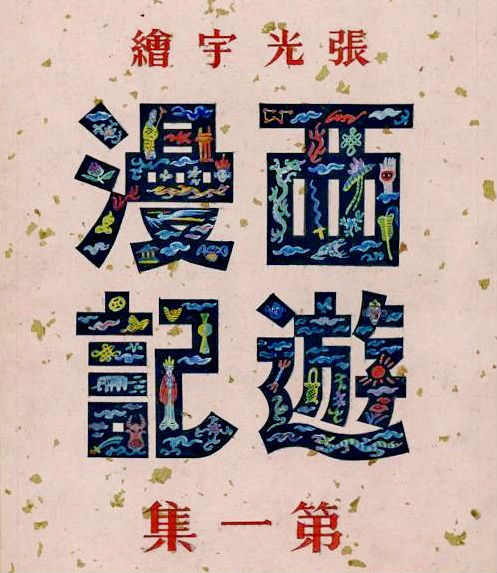
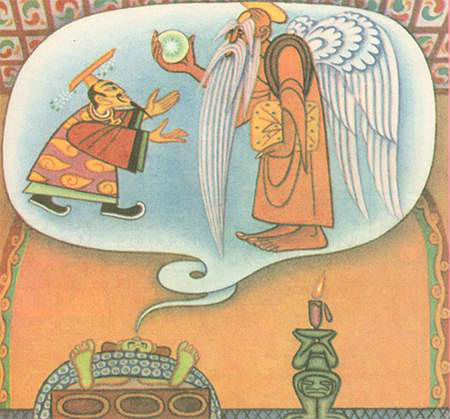
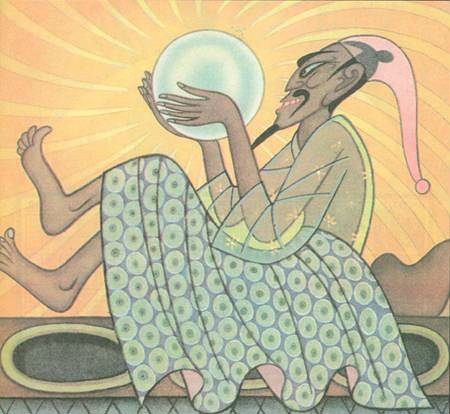
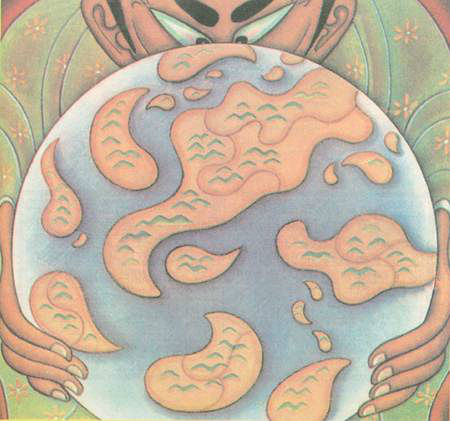
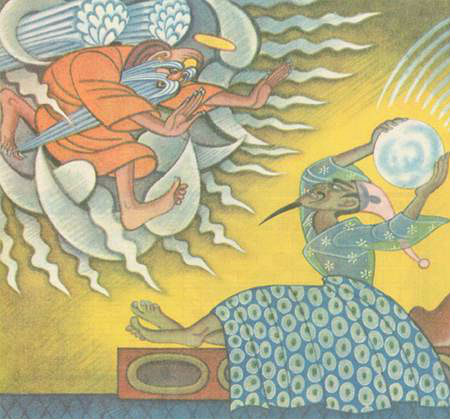
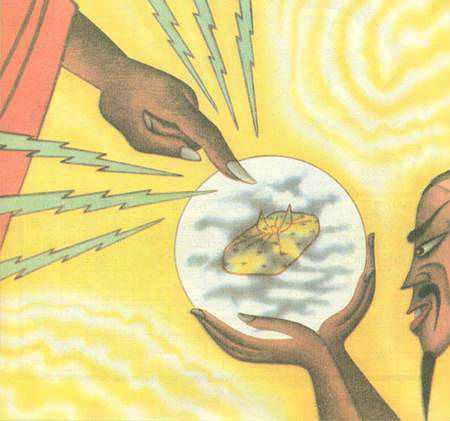

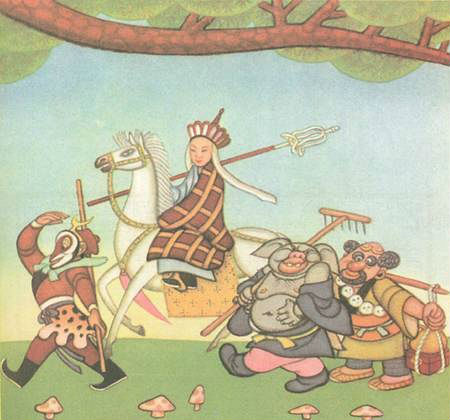
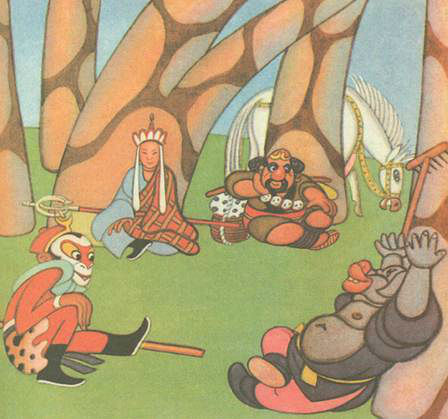
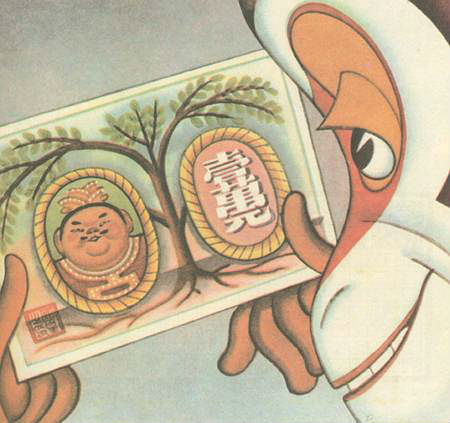
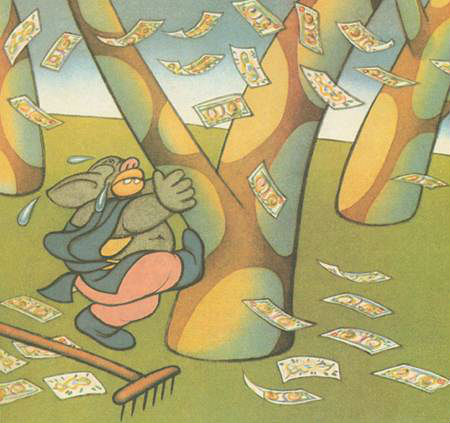




Pingback: Zhang Guangyu’s Manhua Journey to the West (1945) - Part 2 of 6 - Nick Stember
Pingback: The Many Faces of Sun Wukong: Three Classic Adaptations of Journey to the West - Nick Stember
Pingback: Zhang Guangyu's Manhua Journey to the West (1945) - Part 3 of 6 - Nick Stember
Pingback: Zhang Guangyu’s Manhua Journey to the West (1945) – Part 5 of 6 - Nick Stember
Pingback: Zhang Guangyu's Manhua Journey to the West (1945) - Part 4 of 6 - Nick Stember